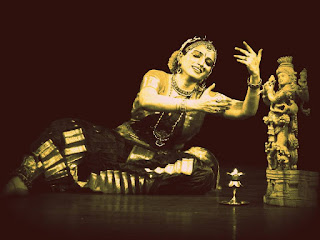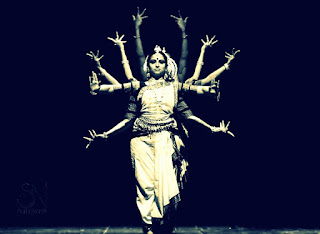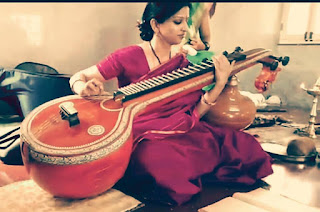|
Sawaal Jawaab - Interview with Srividya Angara - Kuchipudi & Odissi Dancer - June 2016 Sawaal -Jawaab With Srividya - Kuchipudi & Odissi Dancer - June 2016 -Naveena Arts-writer, linguist, singer & translator naveena_b_2002@yahoo.co.in Srividya Angara, Kuchipudi and Odissi Dancer, recently completed her USA Tour. Naveena speaks to her and presents Srividya's thoughts through Sawaal Jawaab. Q: Naveena: Hi Srividya! At the outset, please let us know your Guru(s).Srividya: I’ve been fortunate to learn Kuchipudi from Guru Smt. Yeleswarapu Vijayavalli Priya. Smt. Sharmila Mukherjee is my Guru in Odissi. I’m also very happy to find a mentor in Smt. Sudha Sridhar, who has learnt at the feet of the legendary Kuchipudi Guru Dr. Vempati Chinna Satyam. As the daughter of a Naval Officer, you’ve lived in various cities within India. You’ve also lived abroad on a sojourn post-marriage. Do you think this has had an influence on your art?I was too young in Visakhapatnam and Mumbai to really even understand that aspect. All I was allowed was the walk from home to class, and back. In Hyderabad also, it was the style and aesthetic of the teacher who taught me that mattered more than that of the city. So I think I can say this with confidence, the rhythm of the cities I grew up in hardly influenced my own. That paradigm shifted slightly when I moved to the USA for a couple of years after marriage. As a dancer, I was on my own there, in the town of Charlottesville in Virginia.  Nice! So why Odissi? Was it due to a scarcity of Kuchipudi Gurus, or the challenge of a new form or just an inclination?When I checked online, there weren't any Kuchipudi schools close by, but Sanjali Centre for Odissi dance (headed by Guru Smt. Sharmila Mukherjee) was a stone's throw away. It is not every day that destiny hands you an opportunity like this. And the truth is that I always was fond of Odissi. So when I had a chance to learn it, I did, and with gusto. To be able to learn not one, but two classical dance forms - I consider myself most blessed.  You've learnt the Veena also. So do you involve yourself in the musical aspect of your dance?Yes, I do. A background in instrumental music helps me get a hold on how I would like the music to embrace the choreography I have in mind. The elaboration however, I leave to friends who are professional singers and instrumentalists! What do you find more challenging— performing solo, or working with co-dancers?Each role is enthralling in its own unique way. There is a lot of freedom when performing solo. It is a very liberating experience to dance with abandon, alone. In a group, the energy levels are just spectacular. It is a great feeling to share stage with fellow-dancers, to indulge in that give-and-take of energy. It has become the norm for young, up-and-coming dancers to attend workshops conducted by senior exponents. What is your take on this?I can only speak for myself here and to tell you the truth, I've only attended one dance workshop, to learn a Kuchipudi Tarangam, ‘Jaya jaya Srinivasa’, I once saw performed with much devotion. And I'm very glad to have had that opportunity. There are many items choreographed by great gurus, that I am yet to learn, but practical reasons prevent me from doing so at the moment. It's really each to his/her own here. So whom do you consider your icons?The legends Guru Vempati Chinna Satyam, Guru Kelucharan Mohapatra… their lives are inspiring. To dedicate oneself completely to the nurture and promotion of one’s chosen art … there is a reason they are legends. The saint-poets are icons for me. Thyagaraja, DikshitAr, ShyamaSastri, GoswamiTulsidas, Meerabai … so many personas that light up the dark woods of human thought through their immortal compositions. To them, I bow and turn to constantly for inspiration! I was held steady by the spiritual quality of my parents, and my teachers. That bhakti plays a pivotal role in one's approach to life was a lesson I imbibed early on. That is the common thread that ran through all chapters of my life. In your new role as a Guru, having founded ‘Ćitsabhā Centre for Kuchipudi and allied arts’, how do you propose to teach Kuchipudi? As a strict, disciplinarian teacher or a friendly, accommodating one?To begin with, I’d like to refer to myself as a teacher, and not a guru. And I think I’d fit all the descriptions mentioned in the question! But more than anything, I do believe I’d be a patient teacher. To teach the Kuchipudi idiom in the exacting manner in which it was imparted to me, to those who are willing to learn it from me … that is the first step. Everything else, with the grace of the Goddess of Kuchipudi, Balatripurasundari (whose namesake I incidentally am), will follow. So what do you think of teaching/learning through Skype?Learning is best done in the presence of the teacher, who is physically present in the room along with the student. Nothing can beat that interaction. That said, virtual learning is here to stay. And ready to be harnessed by all. Again, I speak for myself when I say this: to take Skype classes, I need to be confident that students are comfortable learning this way and are smart enough, old enough to assimilate the knowledge transfer. Finally, I would press upon the student to meet as often as time and space would permit, to better the learning process.
That ends an interesting discussion. Here’s wishing the interviewee all success!
(Arts-writer, linguist, singer & translator)
naveena_b_2002@yahoo.co.in
Credits & Keywords- Srividya Angara Sinha, Interview, Naveena, Kuchipudi, Odissi Do Not Copy, Copyrights Acknowledged, PriyaLasya, Hamara, (C), JN16-23-1 |


